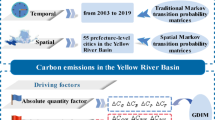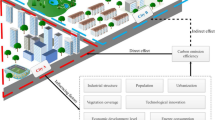Abstract
Clarifying the intrinsic mechanism of county carbon emission intensity (CEI) is essential for guiding the realization of a low-carbon economy as well as for the strategic goals of carbon peaking and carbon neutrality. However, at present, scholars mostly focus on provincial and city scales, with the identification of influencing factors and spatial effect mechanisms of CEI rarely included in the analysis framework. Herein, with the help of three spatial weight matrices, the spatial autocorrelation, the “F + S” influence factor identification method, and the spatial panel econometric model were used to analyze the evolutionary paths and influencing factors of CEI for 209 counties in the Yangtze River Delta (YRD) from 2007 to 2020. The results show that (1) the CEI of the YRD decreased from 1.998t/104 RMB to 0.858t/104 RMB. Furthermore, the spatial pattern was low in the southeast and high in the northwest, with high-value areas concentrated in municipal districts and resource-based counties. (2) Moran’s I spatial autocorrelation index indicated significant spatial clustering of county CEI. (3) Financial science and technology expenditure, industrial structure, share of urban built-up land, and the urban–rural income gap affected the change in CEI and its spatial effect, whereas total imports and exports had a significant negative effect on local CEI. Therefore, to achieve China’s “double carbon” goal, it is necessary to consider the five development concepts as the core, strengthen inter-county exchanges and collaboration, as well as promote collaborative management of the ecological environment.





Similar content being viewed by others
Data availability
The datasets used and/or analyzed in this study are available from the corresponding author upon reasonable request.
References
Anselin L (1995) Local indicators of spatial association-LISA. Geogr Anal 27(2):93–115
Bhattacharyya SC, Matsumura W (2010) Changes in the GHG emission intensity in EU-15: lessons from a decomposition analysis. Energy 35(8):3315–3322
Chang K, Chang H (2016) Cutting CO2 intensity targets of interprovincial emissions trading in China. Appl Energy 163:211–221
Chen J, Gao M, Mangla SK, Song M, Wen J (2020) Effects of technological changes on China’s carbon emissions. Technol Forecast Soc Chang 153
Cheng Y, Wang Z, Ye X, Wei YD (2014) Spatiotemporal dynamics of carbon intensity from energy consumption in China. J Geog Sci 24(4):631–650
Elhorst JP (2012) Matlab software for spatial panels. Int Reg Sci Rev 37(3):389–405
Elhorst JP (2010) Spatial panel data models. In: Fischer M, Getis A (eds) Handbook of Applied Spatial Analysis. Springer, New York, pp 377–407
Gao Z, Li S, Cao X, Li Y (2022) Carbon emission intensity characteristics and spatial spillover effects in counties in northeast China: based on a spatial econometric model. Land 11(5):753
Hao Y, Liu Y, Weng J-H, Gao Y (2016) Does the Environmental Kuznets Curve for coal consumption in China exist? New evidence from spatial econometric analysis. Energy 114:1214–1223
Hong S, Hui EC-m, Lin Y (2022) Relationship between urban spatial structure and carbon emissions: a literature review. Ecol Indic 144:109456
Huang H, Liu H, Peng C, Liao T (2022) Do local fiscal expenditures promote the growth of profit-seeking enterprise numbers in neighboring areas? Economies 10(2):34
Jeong K, Kim S (2013) LMDI decomposition analysis of greenhouse gas emissions in the Korean manufacturing sector. Energy Policy 62:1245–1253
Jotzo F, Pezzey JCV (2007) Optimal intensity targets for greenhouse gas emissions trading under uncertainty. Environ Resour Econ 38(2):259–284
Lee L, Yu J (2010) Estimation of spatial autoregressive panel data models with fixed effects. J Econom 154(2):165–185
Lesage J, Pace RK (2009) Introduction to spatial econometrics. Chapman and Hall/CRC, London
Li B, Gasser T, Ciais P, Piao S, Tao S, Balkanski Y, Hauglustaine D, Boisier J, Chen Z, Huang M, Li LZ, Li Y, Liu H, Liu J, Peng S, Shen Z, Sun Z, Wang R, Wang T, Yin G, Yin Y, Zeng H, Zeng Z, Zhou F (2016) The contribution of China’s emissions to global climate forcing. Nature 531(7594):357–361
Li M, Zhang M, Du C, Chen Y (2020) Study on the spatial spillover effects of cement production on air pollution in China. Sci Total Environ 748:141421
Li J, Huang X, Chuai X, Yang H (2021) The impact of land urbanization on carbon dioxide emissions in the Yangtze River Delta, China: a multiscale perspective. Cities 116:103275
Liu Y, Gao C, Lu Y (2017) The impact of urbanization on GHG emissions in China: the role of population density. J Clean Prod 157:299–309
Liu Y, Liu M, Wang G, Zhao L, An P (2021) Effect of environmental regulation on high-quality economic development in China-an empirical analysis based on dynamic spatial Durbin model. Environ Sci Pollut Res Int 28(39):54661–54678
Liu L, Tang Y, Chen Y, Zhou X, Bedra KB (2022) Urban sprawl and carbon emissions effects in city areas based on system dynamics: a case study of Changsha City. Appl Sci 12(7):3244
Long H, Zou J, Li T, Liu Y (2012) Study on the characteristics and territorial type of rural transformation development: the case of “Southern Jiangsu-Northern Shaanxi” transect. Geogr Res 31(03):495–506
Long R, Yang R, Song M, Ma L (2015) Measurement and calculation of carbon intensity based on ImPACT model and scenario analysis: a case of three regions of Jiangsu province. Ecol Ind 51:180–190
Long Z, Zhang Z, Liang S, Chen X, Ding B, Wang B, Chen Y, Sun Y, Li S, Yang T (2021) Spatially explicit carbon emissions at the county scale. Resour Conserv Recycl 173:105706
Lv T, Hu H, Zhang X, Xie H, Wang L, Fu S (2022) Spatial spillover effects of urbanization on carbon emissions in the Yangtze River Delta urban agglomeration, China. Environ Sci Pollut Res Int 29(23):33920–33934
Mehmood U, Agyekum EB, Uhunamure SE, Shale K, Mariam A (2022) Evaluating the influences of natural resources and ageing people on CO2 emissions in G-11 nations: application of CS-ARDL approach. Int J Environ Res Public Health 19(3):1449
Oda T, Maksyutov S, Andres RJ (2018) The open-source data inventory for anthropogenic CO2, version 2016 (ODIAC2016): a global monthly fossil fuel CO2 gridded emissions data product for tracer transport simulations and surface flux inversions. Earth Syst Sci Data 10:87–107
Pearce J, Kingham S (2008) Environmental inequalities in New Zealand: a national study of air pollution and environmental justice. Geoforum 39(2):980–993
Pomykala A, Szelag A (2022) Reduction of power consumption and CO2 emissions as a result of putting into service high-speed trains: Polish case. Energies 15(12):4206
Qi H, Shen X, Long F, Liu M, Gao X (2022) Spatial–temporal characteristics and influencing factors of county-level carbon emissions in Zhejiang Province, China. Environ Sci Pollut Res 30(4):10136–10148
Schmutzler A (2021) The hidden benefits of high-speed rail. Nat Clim Chang 11(11):902–903
Song M, Wu J, Song M, Zhang L, Zhu Y (2020) Spatiotemporal regularity and spillover effects of carbon emission intensity in China’s Bohai Economic Rim. Sci Total Environ 740:140184
Sun JW (1999) The nature of CO2 emission Kuznets curve. Energy Policy 27(12):691–694
Sun X, Cheng S, Lang J, Ren Z, Sun C (2018) Development of emissions inventory and identification of sources for priority control in the middle reaches of Yangtze River Urban Agglomerations. Sci Total Environ 625:155–167
Sun W, Huang C (2022) Predictions of carbon emission intensity based on factor analysis and an improved extreme learning machine from the perspective of carbon emission efficiency. J Clean Prod 338:130414
Tang R, Zhao J, Liu Y, Huang X, Zhang Y, Zhou D, Ding A, Nielsen CP, Wang H (2022) Air quality and health co-benefits of China’s carbon dioxide emissions peaking before 2030. Nat Commun 13(1):1008
Tian K, Zhang Y, Li Y, Ming X, Jiang S, Duan H, Yang C, Wang S (2022) Regional trade agreement burdens global carbon emissions mitigation. Nat Commun 13(1):408
Tobler WR (1970) A computer movie simulating urban growth in the Detroit Region. Econ Geogr 46:234–240
Wang L, Zhang M (2021) Exploring the impact of narrowing urban-rural income gap on carbon emission reduction and pollution control. PLoS One 16(11):e0259390
Wang Y, Zheng Y (2021) Spatial effects of carbon emission intensity and regional development in China. Environ Sci Pollut Res Int 28(11):14131–14143
Wang L, Yuan F, Duan X (2018) How high-speed rail service development influenced commercial land market dynamics: a case study of Jiangsu province, China. J Transp Geogr 72:248–257
Wang S, Huang Y, Zhou Y (2019) Spatial spillover effect and driving forces of carbon emission intensity at the city level in China. J Geog Sci 29(2):231–252
Wang Y, Duan X, Liang T, Wang L, Wang L (2022) Analysis of spatio-temporal distribution characteristics and socioeconomic drivers of urban air quality in China. Chemosphere 291(Pt 2):132799
Wu C, Huang X, Chen B (2020) Telecoupling mechanism of urban land expansion based on transportation accessibility: a case study of transitional Yangtze River economic Belt, China. Land Use Policy 96:104687
Yang J, Huang X (2021) The 30 m annual land cover dataset and its dynamics in China from 1990 to 2019. Earth Syst Sci Data 13(8):3907–3925
Ye C, Sun C, Chen L (2018) New evidence for the impact of financial agglomeration on urbanization from a spatial econometrics analysis. J Clean Prod 200:65–73
York R, Rosa EA, Dietz T (2003) STIRPAT, IPAT and ImPACT: analytic tools for unpacking the driving forces of environmental impacts. Ecol Econ 46(3):351–365
Zeng C, Song Y, Cai D, Hu P, Cui H, Yang J, Zhang H (2019) Exploration on the spatial spillover effect of infrastructure network on urbanization: a case study in Wuhan urban agglomeration. Sustain Cities Soc 47:101476
Zhang S, Li Z, Ning X, Li L (2021) Gauging the impacts of urbanization on CO2 emissions from the construction industry: evidence from China. J Environ Manag 288:112440
Zhang X, Chen L, Yuan R (2020) Effect of natural and anthropic factors on the spatiotemporal pattern of haze pollution control of China. J Clean Prod 251:119531
Zhang X, Wang X, Zhang C, Zhai J (2022) Development of a cross-scale landscape infrastructure network guided by the new Jiangnan watertown urbanism: a case study of the ecological green integration demonstration zone in the Yangtze River Delta, China. Ecol Indic 143:13
Zheng B, Zhang Q, Davis SJ, Ciais P, Hong C, Li M, Liu F, Tong D, Li H, He K (2018) Infrastructure shapes differences in the carbon intensities of Chinese cities. Environ Sci Technol 52(10):6032–6041
Acknowledgements
This research was supported by the National Key R&D Program of China (2018YFD1100101), National Natural Science Foundation of China (42101318), and Natural Science Foundation of Jiangsu Province, China (BK20200109).
Author information
Authors and Affiliations
Contributions
Zhiyuan Ma, Jiayu Kang, and Ruxian Yun contributed to data collection and analysis; Xuejun Duan and Lei Wang designed the research and provided guidance on manuscript writing, and Zhiyuan Ma and Yazhu Wang wrote the manuscript. All authors have read and approved the final manuscript.
Corresponding author
Ethics declarations
Ethics approval and consent to participate
Not applicable.
Consent for publication
Not applicable.
Competing interests
The authors declare no competing interests.
Additional information
Responsible Editor: V.V.S.S. Sarma
Publisher's Note
Springer Nature remains neutral with regard to jurisdictional claims in published maps and institutional affiliations.
Rights and permissions
Springer Nature or its licensor (e.g. a society or other partner) holds exclusive rights to this article under a publishing agreement with the author(s) or other rightsholder(s); author self-archiving of the accepted manuscript version of this article is solely governed by the terms of such publishing agreement and applicable law.
About this article
Cite this article
Ma, Z., Duan, X., Wang, L. et al. Dynamic evolutionary characteristics and influence mechanisms of carbon emission intensity in counties of the Yangtze River Delta, China. Environ Sci Pollut Res 30, 119974–119987 (2023). https://doi.org/10.1007/s11356-023-30392-0
Received:
Accepted:
Published:
Issue Date:
DOI: https://doi.org/10.1007/s11356-023-30392-0




